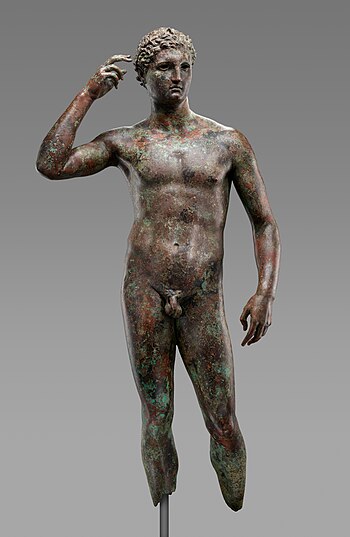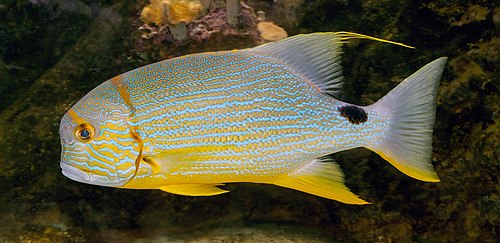Wikipedia:Picture of the day/August 2024
|
Featured picture tools: |
These featured pictures, as scheduled below, appeared as the picture of the day (POTD) on the English Wikipedia's Main Page in August 2024. Individual sections for each day on this page can be linked to with the day number as the anchor name (e.g. [[Wikipedia:Picture of the day/August 2024#1]] for August 1).
You can add an automatically updating POTD template to your user page using {{Pic of the day}} (version with blurb) or {{POTD}} (version without blurb). For instructions on how to make custom POTD layouts, see Wikipedia:Picture of the day.
August 1

|
The edible frog or green frog (Pelophylax kl. esculentus) is a common European frog species that occurs naturally from the northern half of France to western Russia and from Estonia and Denmark to Bulgaria and northern Italy, and is also an introduced species in other parts of the continent. It is a fertile hybrid of the pool frog (Pelophylax lessonae) and the marsh frog (P. ridibundus) and reproduces using hybridogenesis, a process in which one parental genome is excluded. The species is used as food – particularly in France, as well as Germany and Italy – as the delicacy frog legs. This edible frog was photographed in the Danube delta east of Tulcea, Romania. Photograph credit: Charles J. Sharp
Recently featured:
|
August 2

|
Sedum acre, commonly known as the biting stonecrop, is a perennial flowering plant in the family Crassulaceae. It is native to Europe, North Africa and parts of Asia, and is naturalised in other places such as North America and New Zealand. It is a low-growing plant which is adapted for growth on thin dry soils, being found on terrain including dry grassland, beaches, drystone walls and roadside verges. The plant forms mat-like stands up to 12 centimetres (5 inches) tall. For most of the year the stems are short with dense leaf coverage, but during the flowering season in June and July, the stems lengthen and become erect. This S. acre plant with a length of 3.5 centimetres (1.4 inches) was photographed in Niitvälja, Estonia. Photograph credit: Ivar Leidus
Recently featured:
|
August 3

|
Belva Ann Lockwood (1830–1917) was an American lawyer, politician, educator, and author who was active in the women's rights and women's suffrage movements. She was one of the first women lawyers in the United States, and in 1879 she became the first woman to be admitted to practice law before the U.S. Supreme Court. She later ran for president, one of the first women to do so, in the 1884 and 1888 presidential elections, on the ticket of the National Equal Rights Party. This albumen silver print of a photograph of Lockwood was taken around 1880 by Benjamin Joseph Falk. Photograph credit: Benjamin Joseph Falk; restored by Adam Cuerden
Recently featured:
|
August 4

|
|
The IceCube Neutrino Observatory is a neutrino detector constructed at the Amundsen–Scott South Pole Station in Antarctica. Similar to its predecessor, the Antarctic Muon And Neutrino Detector Array, IceCube consists of spherical optical sensors called Digital Optical Modules, each with a photomultiplier tube, located under the Antarctic ice and distributed over a cubic kilometre. The project is a recognized CERN experiment and construction was completed in 2010. This photograph shows the exterior of the IceCube building in 2023. Photograph credit: Christopher Michel
Recently featured:
|
August 5

|
The Malabar pied hornbill (Anthracoceros coronatus) is a bird in the hornbill family of tropical near-passerines. It is a common resident breeder in India and Sri Lanka, where its habitat is evergreen and moist deciduous forests, often near human settlements. It is an omnivorous species, consuming fruits, small mammals, birds, small reptiles and insects. It eats by killing its prey and swallowing it whole. Figs are an important food, contributing at least 60% of the bird's diet throughout the year. It breeds in March and April, during which time figs form up to 75% of the fruits delivered at the nest. This Malabar pied hornbill was photographed in Yala National Park, Sri Lanka. Photograph credit: Charles J. Sharp
Recently featured:
|
August 6

|
|
ATLAS is the largest general-purpose particle detector experiment at the Large Hadron Collider (LHC), a particle accelerator at CERN (the European Organization for Nuclear Research) in Switzerland. The experiment is designed to take advantage of the unprecedented energy available at the LHC and observe phenomena that involve highly massive particles which were not observable using earlier lower-energy accelerators. ATLAS was one of the two LHC experiments involved in the discovery of the Higgs boson in July 2012. It was also designed to search for evidence of theories of particle physics beyond the Standard Model. This image shows the eight toroid magnets surrounding the calorimeter in the centre. Photograph credit: Maximilien Brice, CERN
Recently featured:
|
August 7

|
|
Takht-i-Bahi are the ruins of a 1st-century CE Buddhist monastery complex located in what was once the ancient Indian region of Gandhara, in the present-day northern Pakistani province of Khyber Pakhtunkhwa. It is representative of Buddhist monastic architecture from its era and the ruins were listed as a World Heritage Site in 1980, with UNESCO describing it as having been "exceptionally well-preserved". Pictured here is an aerial view of the complex, showing its various chambers and courtyards. Photograph credit: Muzamil Hussain Toori; retouched by UnpetitproleX
Recently featured:
|
August 8

|
Swallowtail butterflies are large, colorful butterflies in the family Papilionidae, and include over 550 species. Though the majority are tropical, swallowtails inhabit every continent except Antarctica. The family includes the largest butterflies in the world, the birdwing butterflies of the genus Ornithoptera. This Zerynthia rumina butterfly, also known as the Spanish festoon, was photographed in Extremadura, Spain. Photograph credit: Charles J. Sharp
Recently featured:
|
August 9

|
John C. Dancy (1857–1920) was an American politician, journalist, and educator. For many years he was the editor of African Methodist Episcopal newspapers Star of Zion and then Zion Quarterly. In 1897 he was appointed collector of customs at Wilmington, North Carolina, but was chased out of town in the Wilmington massacre of 1898, in part for his activity in the National Afro-American Council which he helped found and of which he was an officer. He then moved to Washington, D.C., where he served as recorder of deeds from 1901 to 1910. His political appointments came in part as a result of the influence of his ally, Booker T. Washington. Photograph credit: Turner; restored by Adam Cuerden
Recently featured:
|
August 10

|
The chestnut-headed bee-eater (Merops leschenaulti) is a bird in the bee-eater family, Meropidae, which is distributed in an area ranging from India, Bangladesh and Sri Lanka across Southeast Asia to Indonesia. It is 18–20 cm (7.1–7.9 in) in overall length and weighs 26–33 g (0.92–1.16 oz), with the sexes being similar in appearance. It is a multi-coloured bird, with parts of the bird such as the forehead and nape being chestnut, and other parts being green, yellow, black and blue. It eats predominantly insects, especially bees, wasps and hornets, which are caught in the air by sorties from an open perch. This chestnut-headed bee-eater was photographed in Yala National Park, Sri Lanka. Photograph credit: Charles J. Sharp
Recently featured:
|
August 11

|
The Victorious Youth is a Greek bronze sculpture created between 300 and 100 BCE. It is currently displayed at the Getty Villa, a museum in Pacific Palisades, California. The sculpture was found in the summer of 1964 in the sea off Fano on the Adriatic coast of Italy, snagged in the nets of an Italian fishing trawler. In 1977, the J. Paul Getty Museum purchased the bronze. Bernard Ashmole, an archaeologist and art historian, was asked to inspect the sculpture by Munich art dealer Heinz Herzer; Ashmole and other scholars attributed it to Lysippos, a prolific sculptor of Classical Greek art. The research and conservation of the Victorious Youth dates from the 1980s to the 1990s and is based on studies in classical bronzes by ancient Mediterranean specialists in collaboration with the Getty Museum. Scholars have various theories as to the identity of the subject, the least controversial of which is that the figure was an ancient Olympic runner who held a victor's palm branch in his left arm. His right hand reaches to touch the winner's olive wreath on his head. Sculpture credit: attributed to Lysippos; photographed by the J. Paul Getty Museum
Recently featured:
|
August 12

|
|
Ages Ago is a musical entertainment with an English-language libretto by W. S. Gilbert and music by Frederic Clay that premiered in 1869 at the Royal Gallery of Illustration in London. It marked the beginning of a seven-year collaboration between Gilbert and Clay. The piece features a haunted Scottish castle inhabited by Sir Ebenezer Tare, with other characters including his niece, her poor suitor and a housekeeper with second sight. The paintings of the castle's former owners come to life and step out of their frames. Gilbert re-used the device of paintings coming to life in his 1887 opera with Arthur Sullivan, Ruddigore. Ages Ago was a critical and popular success and was revived many times, including at St. George's Hall, London, in 1870 and 1874, and in New York in 1880. This chromolithograph theatre poster was created to advertise the original production of Ages Ago and is now in the collection of the Victoria and Albert Museum. Poster credit: Stannard & Son; restored by Adam Cuerden
Recently featured:
|
August 13

|
|
The royal angelfish (Pygoplites diacanthus) is a fish in the marine angelfish family, Pomacanthidae. It is found in tropical seas, including the Red Sea and the Indian Ocean around East Africa and the Maldives, the Tuamotus, New Caledonia, and the Great Barrier Reef. It is also found around Taiwan and islands off the coast of Japan. The royal angelfish has a maximum length of 25.0 centimetres (9.8 inches), with coloration varying by region. A commonality is that the body is edged in narrow blue-white and orange stripes that are narrow and angle backward. It is a carnivorous species, feeding on sponges and tunicates, and resides in coral-rich areas of lagoons and reefs as well as in the vicinity of caves. This royal angelfish was photographed in Ras Muhammad National Park on the Sinai Peninsula in Egypt. Photograph credit: Diego Delso
Recently featured:
|
August 14

|
|
The mango is an edible stone fruit produced by the tropical tree Mangifera indica. It originated from the region between northwestern Myanmar, Bangladesh, and northeastern India, and is now cultivated across the world, having been introduced to East Africa by Arab and Persian traders in the 9th to 10th centuries and spread further into other areas around the world during the European colonial era. Ripe mangoes vary according to cultivar in size, shape, color, and sweetness. They have a waxy, smooth, and fragrant skin, which is variously yellow, orange, red, or green, and feature a single flat, oblong pit that can be fibrous or hairy on the surface. The fruits may be somewhat round, oval, or kidney-shaped, ranging from 5 to 25 centimetres (2 to 10 inches) in length and from 140 grams (5 ounces) to 2 kilograms (5 pounds) in weight. It is used in culinary products around the world. The mango is the national fruit of India and M. indica is the national tree of Bangladesh. This photograph shows two mangoes grown in Brazil, one whole and one sectioned. The picture was focus-stacked from 12 separate images. Photograph credit: Ivar Leidus
Recently featured:
|
August 15

|
The Kefermarkt altarpiece is a richly decorated wooden altarpiece in the Late Gothic style in the parish church of Kefermarkt in Upper Austria. Commissioned by the knight Christoph von Zelking, it was completed around 1497. Saints Peter, Wolfgang and Christopher are depicted in the central section. The wing panels depict scenes from the life of Mary, and the altarpiece also has an intricate superstructure and two side figures of Saints George and Florian. The identity of its maker, known by the notname Master of the Kefermarkt Altarpiece, is unknown, but at least two skilled sculptors appear to have created the main statuary. Throughout the centuries, it has been altered and lost its original paint and gilding; a major restoration was undertaken in the 19th century under the direction of Adalbert Stifter. The altarpiece has been described as "one of the greatest achievements in late-medieval sculpture in the German-speaking area". This image shows the lower-left wing panel of the Kefermarkt altarpiece, depicting the death of Mary. She lies peacefully in her deathbed, while a diminutive angel holds the curtain apart so that the viewer can see Mary better. The twelve apostles are all present, each one depicted with individual traits. Above the head of Saint Peter, Christ appears in a cloud, receiving the soul of his mother in the form of a small figure. Sculpture credit: Master of the Kefermarkt Altarpiece; photographed by Uoaei1
Recently featured:
|
August 16

|
Ceramica pisi, the broom moth, is a species of moth of the family Noctuidae. It is found in a range covering the whole of Europe from the Arctic Circle to northern Spain, and across to the Russian Far East. It lives at heights of up to 2,000 metres. This photograph shows a broom moth caterpillar in Estonia. Photograph credit: Ivar Leidus
Recently featured:
|
August 17

|
|
NGC 3324 is an open cluster in the southern constellation Carina, located northwest of the Carina Nebula at a distance of 9,100 ly (2,800 pc) from Earth. The two are often confused as a single object, and together have been nicknamed the "Gabriela Mistral Nebula" due to its resemblance to the Chilean poet. NGC 3324 was first catalogued by James Dunlop in 1826. This infrared photograph by NASA’s James Webb Space Telescope shows a young, star-forming region in the western section of NGC 3324 known as the "Cosmic Cliffs". Photograph credit: NASA
Recently featured:
|
August 18

|
W. E. B. Du Bois (1868–1963) was an American sociologist, historian and civil rights activist. The first African American to earn a doctorate from Harvard, he became a professor of history, sociology and economics at Atlanta University. He rose to national prominence as the leader of the Niagara Movement, a group of African-American activists who wanted equal rights for blacks, and was one of the co-founders of the NAACP in 1909. He wrote one of the first scientific treatises in the field of American sociology, and published three autobiographies. Black Reconstruction in America (1935) challenged the prevailing orthodoxy that blacks were responsible for the failures of the Reconstruction era. On August 28, 1963, a day after his death, his book The Souls of Black Folk was highlighted by Roy Wilkins at the March on Washington, and hundreds of thousands of marchers honored him with a moment of silence. A year later, the Civil Rights Act of 1964, embodying many of the reforms for which he had campaigned his entire life, was enacted. This gelatin silver print of Du Bois was taken in 1907 by the American photographer James E. Purdy, and is in the collection of the National Portrait Gallery in Washington, D.C. Photograph credit: James E. Purdy; restored by Adam Cuerden
Recently featured:
|
August 19

|
The dusky seaside sparrow (Ammospiza maritima nigrescens) was a non-migratory subspecies of the seaside sparrow, found in Florida in the natural salt marshes of Merritt Island and along the St. Johns River. Discovered in 1872 by Charles Johnson Maynard, it was distinguished from other seaside sparrows by its dark coloration and distinct song. From the 1940s onwards, the dusky seaside sparrow population declined and eventually went extinct. This was the result of human activity in the area including pesticides and flooding applied to reduce mosquito populations, industrial expansion, and highway construction. The last definite known individual died on Discovery Island in Walt Disney World in 1987, and the subspecies was declared extinct in 1990. Photograph credit: P. W. Sykes, United States Fish and Wildlife Service
Recently featured:
|
August 20

|
|
The Hoher Göll is a mountain in the Berchtesgaden Alps. At 2,522 metres (8,274 feet), it is the highest peak of the Göll massif, which straddles the border between the German state of Bavaria and the Austrian state of Salzburg. This photograph shows the Hoher Göll (left) and the Hohes Brett (right) from the west. Photograph credit: Jörg Braukmamm
Recently featured:
|
August 21

|
Marie Curie (1867–1934) was a Polish and naturalised-French physicist and chemist who conducted pioneering research on radioactivity. Born in Warsaw, she studied in Poland until she was 24, when she moved to Paris to earn her higher degrees. In 1895, she married French physicist Pierre Curie, and in 1903 she shared the Nobel Prize in Physics with Pierre and physicist Henri Becquerel for their pioneering work developing the theory of "radioactivity" – a term she coined. She was the first woman to win a Nobel Prize. She won a second Nobel Prize in 1911, the first person to do so, for her discovery of the elements polonium and radium. Under her direction, the world's first studies were conducted into the treatment of neoplasms by the use of radioactive isotopes. During World War I, she developed mobile radiography units to provide X-ray services to field hospitals. She founded the Curie Institute in Paris in 1920, and the Curie Institute in Warsaw in 1932. This photograph of Curie was taken in around 1920 by French photographer Henri Manuel. Photograph credit: Henri Manuel; restored by FMSky and Bammesk
Recently featured:
|
August 22

|
|
The sailfin snapper (Symphorichthys spilurus) is a species of marine ray-finned fish in the snapper family, Lutjanidae. It is found in the eastern Indian Ocean and the western Pacific Ocean, at depths between 5 and 60 metres (16 and 197 feet). It lives in areas of sand near to reefs in lagoons and over outer reefs. The sailfin snapper is targeted in mixed-species fisheries throughout its range, being caught predominantly using handlines and bottom trawling. The juveniles appear in the aquarium trade. This sailfin snapper was photographed in Wilhelma, a zoological–botanical garden in Stuttgart, Germany. Photograph credit: H. Zell
Recently featured:
|
August 23

|
Portrait of Ambroise Vollard is an 1899 oil-on-canvas portrait by Paul Cézanne of his art dealer Ambroise Vollard. It was bequeathed by Vollard on his death to the Petit Palais in Paris, where it is still housed today. Like many of his portraits, the Portrait of Ambroise Vollard displays the significant role of the subject in Cézanne's life, and specifically, the artist's gratitude for promoting his work and establishing his reputation as an artist. Painting credit: Paul Cézanne
Recently featured:
|
August 24

|
Baryte is a mineral consisting of barium sulfate (BaSO4). Generally white or colorless, it is the main source of the element barium, an alkaline earth metal. It is found across the world and can be deposited through biogenic and hydrothermal processes or evaporation. Early records of baryte date to the 16th century, when a radiating form gained notoriety among alchemists for specimens found near Bologna, Italy. Carl Wilhelm Scheele determined that baryte contained a new element in 1774, but elemental barium was not isolated until 1808 by Humphry Davy, using electrolysis of molten barium salts. Modern uses of baryte include oil and gas drilling, oxygen and sulfur isotopic analysis, and radiometric dating. These crystals of baryte on a dolomite crystal matrix were found at Cerro Warihuyn in Miraflores District, Peru. This photograph was focus-stacked from 24 separate images. Photograph credit: Ivar Leidus
Recently featured:
|
August 25

|
|
The splendid fairywren (Malurus splendens) is a passerine bird in the Australasian wren family, Maluridae. It is found across much of the Australian continent from central-western New South Wales and southwestern Queensland over to coastal Western Australia. It inhabits predominantly arid and semi-arid regions. Exhibiting a high degree of sexual dimorphism, the male in breeding plumage is a small, long-tailed bird of bright blue and black colouration. Non-breeding males, females and juveniles are grey-brown in colour; this gave the early impression that males were polygamous as all dull-coloured birds were taken for females. The species comprises several similar all-blue and black subspecies that were originally considered to be separate species. Like other fairywrens, the splendid fairywren is notable for several peculiar behavioural characteristics; birds are socially monogamous and sexually promiscuous, meaning that although they form pairs between one male and one female, each partner will mate with other individuals and even assist in raising the young from such pairings. Male wrens pluck pink or purple petals and display them to females as part of a courtship display. This male splendid fairywren was photographed in Cargelligo State Forest in New South Wales, Australia. Photograph credit: John Harrison
Recently featured:
|
August 26

|
George Roper was a four-masted iron barque that was built for service between England and Australia, launching from Liverpool in February 1883. On its maiden voyage, it carried 3,842 tons of cargo, including railway track for the Victorian Government, liquor, chemicals, drapery, and dynamite. It reached Australia in July, but got caught on the reef at Point Lonsdale while being towed into Port Melbourne. The ship sat there for nearly two months before breaking up and sinking on 26 August 1883. The wreck remains under 4–5 metres of water and is accessible to recreational divers. This photograph by the German-born photographer Fred Kruger shows George Roper's wreck at Point Lonsdale before it sank. Photograph credit: Fred Kruger; restored by Adam Cuerden
Recently featured:
|
August 27

|
|
Warsaw is the capital and largest city of Poland, located on the Vistula in the east-central part of the country. It has an estimated population of 1.86 million, within a larger metropolitan area of 3.27 million residents, and it is a major cultural, political and economic hub. Warsaw originated as a small fishing town in Masovia, rising to prominence in the late 16th century when Sigismund III moved the Polish capital and his royal court from Kraków. It was the de facto capital of the Polish–Lithuanian Commonwealth until 1795 and then the seat of Napoleon's Duchy of Warsaw. The 19th century and its Industrial Revolution brought a demographic boom. Warsaw was bombed and besieged at the start of World War II in 1939, and its infrastructure and population suffered during the systematic razing which followed the Warsaw Uprising in 1944. The modern city features many historic monuments, including the reconstructed Old Town, designated a World Heritage Site. This 2022 photograph shows an elevated view of Warsaw's Constitution Square, looking northwards down Marszałkowska Street. Photograph credit: Emptywords
Recently featured:
|
August 28

|
Danafungia scruposa is a species of coral found in the eastern and western Indian Ocean, the eastern central, northwestern and western central Pacific Ocean, Japan, the East China Sea, the Red Sea, and eastern Australia. It is around 25 centimetres (9.8 inches) in diameter and normally consumes a variety of food from bacteria to mesozooplankton measuring 1 mm (0.039 in) in diameter. During an algal bloom in 2009, researchers observed D. scruposa consuming the jellyfish Aurelia aurita, the first time such behaviour had been seen in the wild. This D. scruposa coral was photographed in the Red Sea off the Egyptian coast. Photograph credit: Diego Delso
Recently featured:
|
August 29

|
Tom Taylor (1817–1880) was an English dramatist, public servant and writer. After a brief academic career in English literature and language at University College London in the 1840s, Taylor practised law and became a civil servant. At the same time he became a journalist, most prominently as a contributor to and eventually the editor of the magazine Punch. He also began a theatre career and is now best known as a playwright. With up to one hundred plays staged during his career, both original work and adaptations of French plays, Taylor's output covers a range of genres from farce to melodrama. Most fell into neglect after Taylor's death, but Our American Cousin (1858), which achieved great success in the 19th century, remains famous as the piece that was being performed in the presence of Abraham Lincoln when he was assassinated in 1865. This undated photograph by the studio of Samuel Robert Lock and George C. Whitfield is part of Men of Mark: A Gallery of Contemporary Portraits, a collection published in 1881. Photograph credit: Lock & Whitfield; restored by Adam Cuerden
Recently featured:
|
August 30

|
Oregano (Origanum vulgare) is a species of flowering plant in the mint family, Lamiaceae. It was native to the Mediterranean region, but widely naturalised elsewhere in the temperate Northern Hemisphere. A relative of the herb marjoram, oregano has purple, pink or white flowers and spade-shaped, olive-green leaves. It is a perennial, but it is grown as an annual in colder climates as it often does not survive the winter. Oregano leaves are widely used as a culinary herb, and its oil is often used as a dietary supplement, although there is no clinical evidence that it has any effect on human health. This photograph of an inflorescence of oregano was taken in Keila, Estonia; the petals of the flowers depicted are approximately 5 millimetres (0.20 inches) in length. This picture was focus-stacked from 66 separate images. Photograph credit: Ivar Leidus
Recently featured:
|
August 31

|
|
The red-tailed hawk (Buteo jamaicensis) is a bird of prey that breeds throughout most of North America, from the interior of Alaska and northern Canada to as far south as Panama and the West Indies. It occupies a wide range of habitats and altitudes, including deserts, grasslands, forests, agricultural fields, and urban areas. Red-tailed hawks are opportunistic generalists and their diet is variable. In North America, they are most often predators of small mammals such as rodents. Prey that is terrestrial and at least partially diurnal is preferred, so types such as ground squirrels are preferred where they naturally occur. The bird is legally protected in Canada and Mexico, and in the United States by the Migratory Bird Treaty Act of 1918. This red-tailed hawk in flight was photographed at the Sacramento National Wildlife Refuge in California. Photograph credit: Frank Schulenburg
Recently featured:
|
Picture of the day archives and future dates
